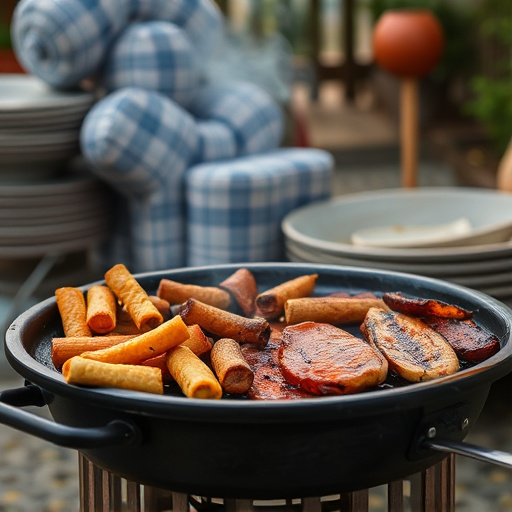Selecting ribs (baby back, spare, St. Louis) aligns with desired flavor profile. Prepare ribs with dry rub, soak wood chips, preheat grill to 400°F/200°C, and manage heat for even cooking. Use a meat thermometer to maintain consistent temp (225-300°F/107-149°C). Baste and time sauce application for crust and flavor reactions. Rest ribs for 10-15 minutes, then slice between bones.
Unleash your inner BBQ master with our comprehensive guide to grilling perfectly cooked barbecue ribs. From choosing the right ribs for your dish to mastering dry rubs, smoking techniques, and temperature control, we’ve got you covered. Learn essential preparation steps, understand the science behind basting and sauce timing, and discover tips for resting and slicing like a pro. Elevate your BBQ game with this ultimate grilling guide for mouthwatering bbq ribs recipe.
- Choosing the Right Ribs for Your BBQ Recipe
- Preparation: Essential Steps Before Grilling
- Master the Art of Dry Rubs for Flavor
- Smoking vs. Direct Grilling: Which Technique Is Best?
- Controlling Temperature for Even Cooking
- The Science Behind Baste and Sauce Timing
- Resting and Slicing: Tips for Perfect Ribs
Choosing the Right Ribs for Your BBQ Recipe
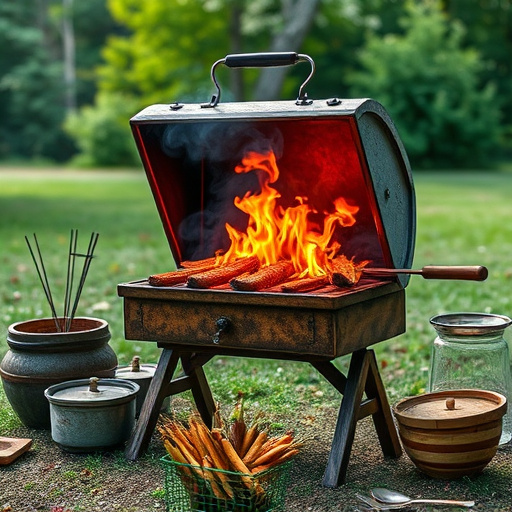
When it comes to grilling perfect barbecue ribs, selecting the right cut is a crucial first step in your BBQ ribs recipe journey. Look for ribs with good marbling—the fat streaks throughout the meat—as this adds flavor and moisture. The most common cuts include baby back ribs, spare ribs, and St. Louis-style ribs, each with distinct characteristics. Baby back ribs are smaller and tenderer, perfect for those who prefer a leaner option. Spare ribs, on the other hand, offer a hearty, meaty experience, ideal for slow-smoking techniques.
For an authentic BBQ ribs recipe, consider the origin of your desired flavor profile. Different regions have unique styles; Memphis-style ribs are known for their dry rub and slow cooking, while Kansas City ribs often feature a sweet tomato-based sauce. Choosing the right ribs to complement your desired taste will enhance the overall grilling experience, ensuring a mouthwatering, tender, and flavorful result.
Preparation: Essential Steps Before Grilling
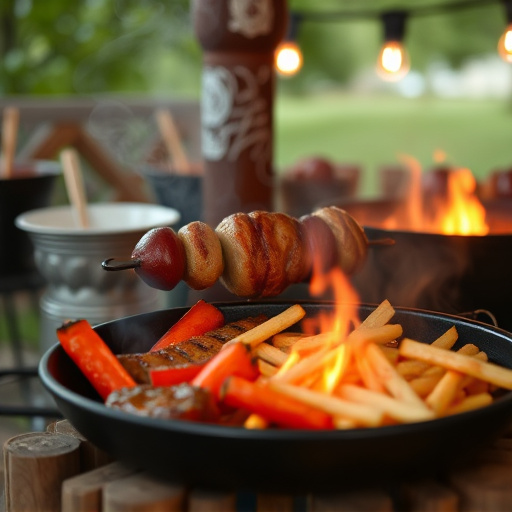
Before grilling your BBQ ribs, proper preparation is key to achieving that perfect, tender, and flavorful result. Start by selecting high-quality, meaty ribs with visible marbling for optimal taste and juiciness. Next, trim any excess fat or silver skin from the bone side of the ribs; this will help render the fat during cooking, adding richness to your dish. A crucial step is dry rubbing; coat both sides generously with a spice blend tailored to your preference. This step enhances flavor and helps create a delicious crust when grilled.
Additionally, consider soaking wood chips or chunks in water for 30 minutes before grilling. These will add natural smoke flavor, enhancing the overall BBQ ribs recipe. Ensure your grill is preheated to high heat (around 400°F/200°C) and use a grill brush to remove any residual ash. This step ensures consistent heat distribution, crucial for slow-cooking ribs to perfection.
Master the Art of Dry Rubs for Flavor
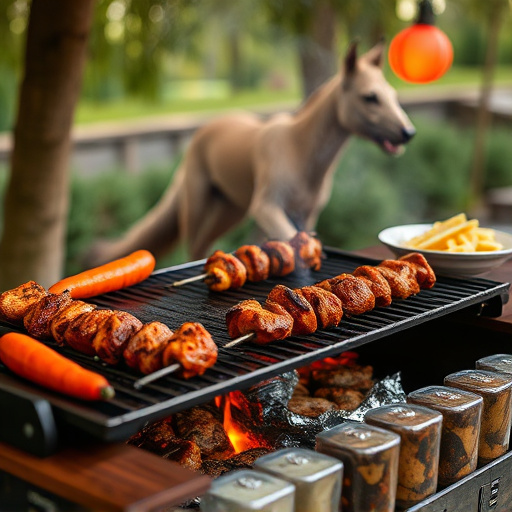
Mastering the art of dry rubs is essential for achieving flavor-packed BBQ ribs on the grill. A dry rub consists of a blend of spices that cling to the meat, infusing it with heat, smoke, and complex tastes. The key is to find the right balance of flavors – a combination that caters to your palate. Experiment with different spice blends, adjusting the quantities for a personalized kick. Common ingredients include brown sugar, paprika, garlic powder, salt, pepper, and chili powder, each contributing its unique note to the overall profile.
When applying the rub, ensure even coverage by massaging it into the rib meat. Allow the ribs to rest with the rub for at least an hour – or even overnight in the refrigerator – so the flavors can penetrate the meat. This step significantly enhances the overall taste experience compared to simply seasoning with salt and pepper before grilling. The result is tender, juicy ribs that sing with flavor from the inside out.
Smoking vs. Direct Grilling: Which Technique Is Best?
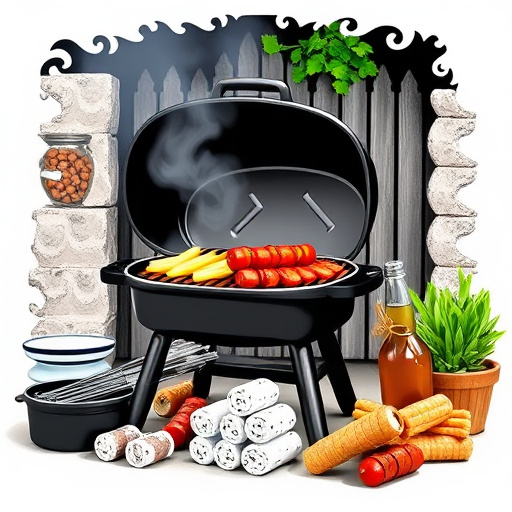
When it comes to grilling BBQ ribs, the age-old debate rages on: smoking vs. direct grilling. Both methods have their devoted followers, but understanding the nuances can elevate your rib game significantly. Smoking, a slower process that involves low and indirect heat, infuses ribs with a deep, rich flavor as the smoke aromatically coats each tender slice. This technique is ideal for larger cuts of meat that benefit from long, slow cooking, ensuring every bite is succulent and tender.
Direct grilling, on the other hand, offers a faster approach, searing the ribs to perfection over high heat. This method creates a beautiful crust on the exterior while locking in juicy flavors. It’s best suited for thinner cuts or ribs that need a quicker turn around time, resulting in a mouthwatering contrast between tender meat and a crispy outer layer. Whether you choose to smoke or grill directly, mastering these techniques is key to unlocking the secrets of the perfect BBQ rib recipe.
Controlling Temperature for Even Cooking
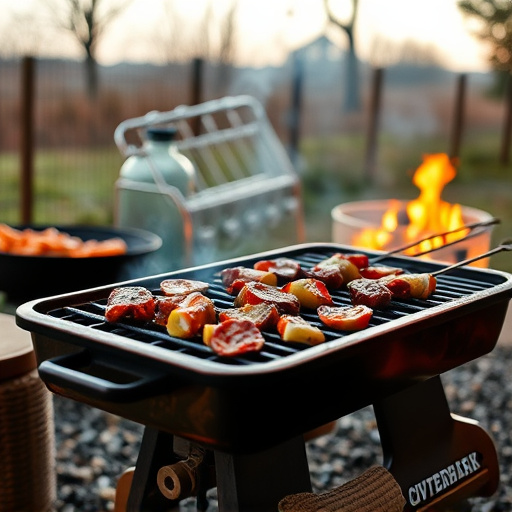
Maintaining a consistent temperature is key to achieving perfectly cooked BBQ ribs on the grill. The ideal cooking range for ribs is typically between 225°F and 300°F (107°C to 149°C). Using a good quality meat thermometer, monitor the internal temperature of the ribs regularly. This ensures they cook evenly, preventing overcooking or burning the exterior while keeping the interior tender and juicy. For a slow-cooked, fall-off-the-bone experience, aim for the lower end of this range, allowing several hours for the heat to gently transform the ribs. If you prefer your ribs with a bit more char, gradually increase the temperature towards the upper limit as they near doneness.
Controlling the grill’s temperature allows you to create a delicious crust on the outside while keeping the meat tender and flavorful. This balance is essential for that mouthwatering BBQ rib recipe you’ve been craving. So, keep an eye on those temperatures and adjust your cooking tactics accordingly for perfect results every time.
The Science Behind Baste and Sauce Timing
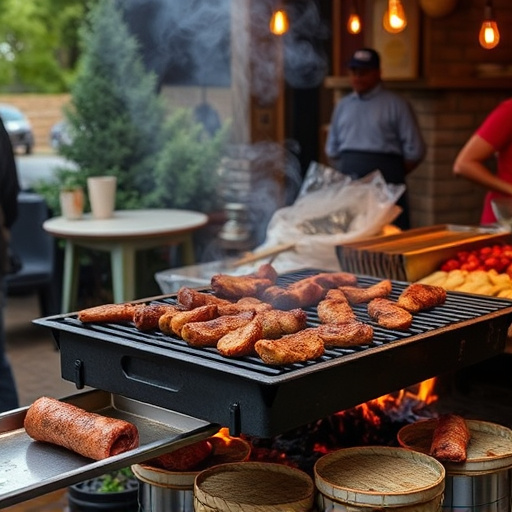
The art of grilling perfect BBQ ribs involves more than just fire and smoke; it’s a science. One key aspect is understanding the magic of basting and sauce timing. When meat is grilled, it undergoes a complex process where proteins denature and sugars caramelize, creating that mouthwatering, sticky glaze. Basting acts as a protective layer, locking in moisture and enhancing these flavor reactions. Applying sauce too early can prevent the formation of this desirable crust, as the sugar content may burn before the rib is fully cooked.
Timing is crucial; baste ribs towards the end of grilling to allow the sauce’s sugars to react with the meat’s surface, resulting in a delicious, perfectly cooked BBQ rib with that perfect balance of tender and saucy. This technique ensures your ribs not only look appetizing but also taste remarkable, making them the centerpiece of any grill gathering.
Resting and Slicing: Tips for Perfect Ribs
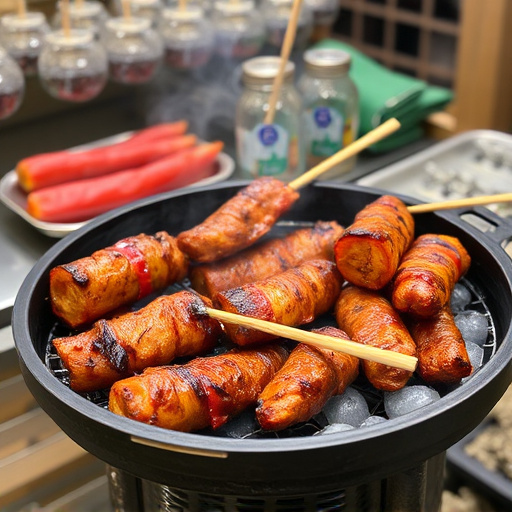
After cooking your BBQ ribs on the grill, proper resting and slicing are crucial for achieving tender, juicy results. Allow the ribs to rest for at least 10-15 minutes before slicing. This allows the juices to redistribute throughout the meat, ensuring every bite is flavorful and moist. During this time, the internal temperature of the ribs will also continue to rise slightly, reaching a perfect level of doneness.
When it’s time to slice, use a sharp knife or a saw-tooth cutter designed for ribs. Cut between the bones, not through them, to maintain the meat’s integrity and prevent excessive moisture loss. Starting at the wide end of the rib and working your way down, thin slices will help the ribs cook evenly and prevent overcooking. This meticulous approach ensures that your BBQ ribs recipe delivers on flavor and texture every time.
